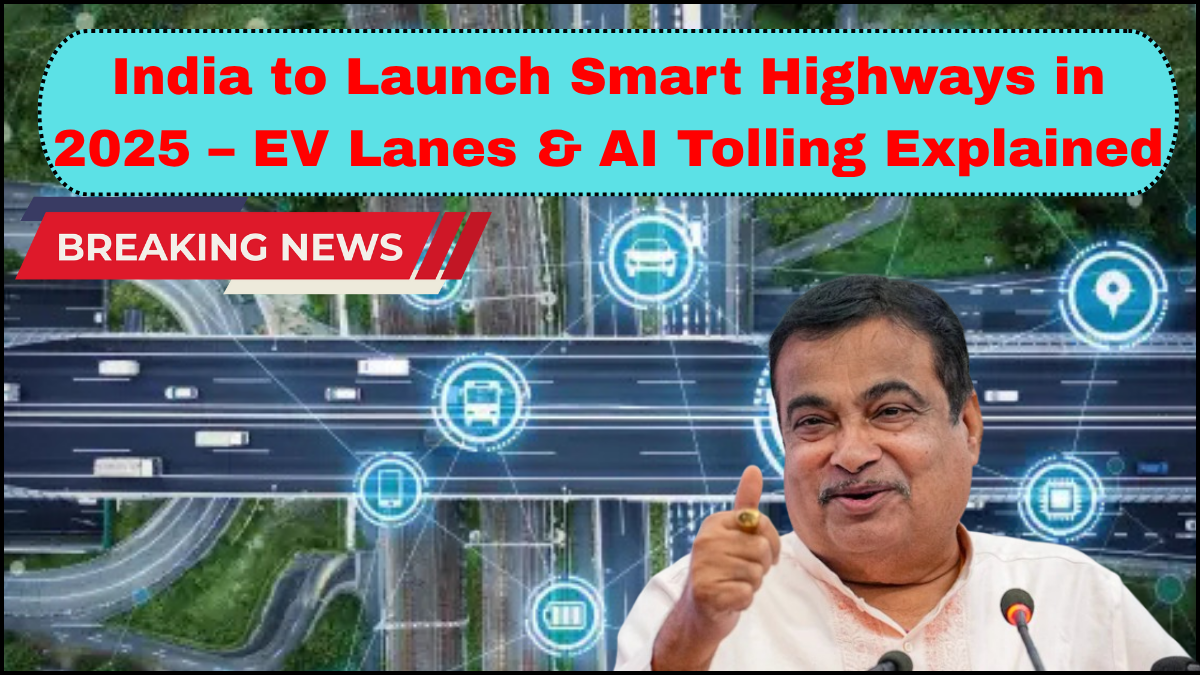India is poised to redefine road infrastructure in 2025 with the much-anticipated Smart Highway Launch in India 2025. These advanced expressways will feature dedicated EV lanes, AI-based tolling systems, and real-time traffic management powered by next-generation technologies. Spearheaded by the Ministry of Road Transport and Highways, this project marks a significant move toward sustainable mobility and digital infrastructure.

Smart Highways: What Makes Them “Smart”?
Smart highways integrate digital intelligence into physical road networks. Unlike conventional highways, these roads are embedded with sensors, Internet of Things (IoT) devices, automated surveillance systems, and Artificial Intelligence (AI) tools. The goal? To optimize traffic flow, enhance safety, and support the seamless movement of electric and connected vehicles.
India’s smart highways in 2025 will incorporate:
-
AI-based toll collection: Eliminating traditional toll booths through automatic number plate recognition (ANPR) and GPS-based payment systems.
-
EV-specific lanes: Designed exclusively for electric vehicles, featuring wireless charging zones and battery swapping stations.
-
Real-time traffic monitoring: Using smart cameras and IoT sensors to predict congestion, accidents, or road wear.
-
Smart lighting and signage: Adaptive lighting systems that respond to vehicle movement and weather conditions.
The Flagship Project: Delhi-Mumbai Corridor
At the heart of the Smart Highway Launch in India 2025 is the Delhi-Mumbai corridor, a critical testbed for innovation. This 1,386-kilometer expressway, currently under phased development, is more than just a link between two economic powerhouses—it’s a prototype for the future of Indian transportation.
Key features include:
-
Dedicated EV lanes to promote clean mobility on one of India’s busiest routes.
-
Green infrastructure, such as solar-powered lighting and rainwater harvesting systems along the corridor.
-
Digital traffic control centers at regular intervals to manage traffic and emergency services through AI insights.
-
5G connectivity zones to support autonomous and connected vehicles.
The Delhi-Mumbai corridor is expected to slash travel time between the two cities from 24 hours to under 13 hours for heavy vehicles, transforming freight movement across northern and western India.
EV Lanes: A Game-Changer for Electric Mobility
One of the standout components of the 2025 smart highways is the integration of EV lanes. These dedicated tracks are a first for India and address some of the core challenges in electric vehicle adoption—charging infrastructure, efficiency, and range anxiety.
Highlights include:
-
In-motion wireless charging: Pilot stretches will allow compatible EVs to charge while driving, improving uptime and efficiency.
-
Battery swap points: Strategically placed for commercial EVs like buses and trucks to minimize downtime.
-
Dynamic signage: Guiding EV drivers to nearby charging stations or traffic advisories using real-time updates.
This initiative supports India’s broader goals under the FAME (Faster Adoption and Manufacturing of Hybrid and Electric Vehicles) scheme and aligns with the push for net-zero emissions by 2070.
AI Tolling and Seamless Payments
Traditional toll plazas are a bottleneck in India’s highway experience. The AI-powered tolling systems to be deployed in 2025 will change that. Leveraging technologies like GPS tracking, ANPR, and AI-driven vehicle classification, toll charges will be calculated and debited automatically without halting the vehicle.
Benefits include:
-
Reduced congestion at toll points.
-
Better compliance through vehicle detection and AI analytics.
-
Data integration with digital wallets and FASTag-like platforms for smoother transactions.
This system also contributes to transparency in toll collection and paves the way for dynamic pricing models based on traffic conditions and peak hours.
Broader Impacts and Long-Term Vision
The smart highway initiative is more than a tech upgrade—it’s a foundational step toward a digitally enabled transport ecosystem. It supports:
-
Reduction in carbon footprint, through greener transportation alternatives and efficient routing.
-
Safer travel, with intelligent surveillance and automated accident response.
-
Job creation in AI, infrastructure, electric vehicle manufacturing, and IoT-based service sectors.
As India urbanizes and motorizes at scale, such projects are essential to balance growth with sustainability.
FAQs
Q1. What is the Smart Highway Launch in India 2025 about?
The Smart Highway Launch in India 2025 refers to the rollout of high-tech expressways featuring AI tolling, EV lanes, smart sensors, and digital traffic management systems.
Q2. What is special about the Delhi-Mumbai corridor?
It’s the pilot and flagship project under the initiative. Spanning over 1,300 km, it includes EV lanes, AI traffic systems, and smart infrastructure to cut travel time and promote green transport.
Q3. How will EV lanes work?
EV lanes will support wireless charging, battery swapping, and real-time navigation assistance for electric vehicles, making long-distance EV travel more practical.
Q4. What role does AI play in the smart highways?
AI manages toll collection, traffic prediction, vehicle recognition, and emergency response, making the highways more efficient and safer.
Q5. When will these smart highways be operational?
The first phase, including parts of the Delhi-Mumbai corridor, is expected to become operational by mid to late 2025.
click here to learn more